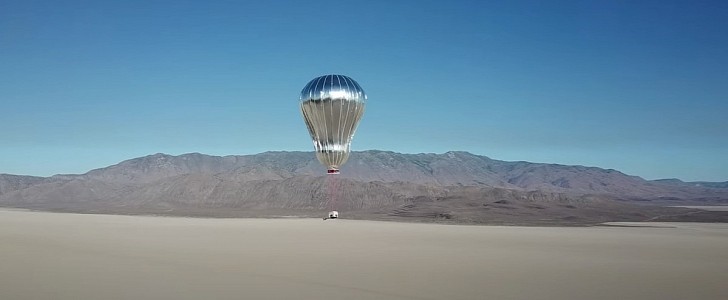NASA's aerial robotic balloon prototype, or aerobot, successfully completed two test flights at Nevada's Black Rock Desert. This prototype is a scaled-down version of the aerobot that could one day fly above Venus' hellish surface.
The only balloons to fly in the skies of Venus arrived at the planet in 1985 as part of the Soviet-led Vega mission. Two balloons were used to explore the atmosphere. Unfortunately, their batteries ran out after about 46 hours. It was a short journey, but it offered a glimpse of what could be achieved in the future by a more advanced aerobot.
NASA's Jet Propulsion Laboratory (JPL) and the Near Space Corporation are working on a balloon that could one day fly between about 171,000 and 203,000 ft (52 and 62 km) within Venus' atmosphere. The one that was tested above the Black Rock Desert is a one-third-scale prototype, but its recent achievements show that engineers are on the right path.
Unlike the previous Vega balloons, NASA's aerobot can be directed to raise and lower its altitude. That's because the prototype is what scientists call a "balloon within a balloon." It contains an inner reservoir that can regulate the amount of helium escaping to and from the outer balloon, which is flexible. The aerobot's capabilities were successfully tested during the flights. Furthermore, the materials utilized were evaluated for the first time, providing the necessary data that will be used to improve the design of a bigger aerobot.
NASA's balloon climbed to more than 4,000 ft (1 km), reaching a layer of Earth's is similar to the temperature and density the aerobot would experience roughly 180,000 f (55 km) above Venus. The crew successfully retrieved the balloon after each test flight.
"The success of these test flights is a huge deal for us: We've successfully demonstrated the technology we'll need for investigating the clouds of Venus," said Paul Byrne, an associate professor at Washington University in St. Louis and aerobot science collaborator.
"These tests form the foundation for how we can achieve long-term robotic exploration high above Venus' hellish surface," he added.
NASA hopes that the final version of the aerobot will be able to circle the planet for at least 100 days by floating on the winds of Venus. If everything goes as planned, the balloon will enable researchers to look for acoustic waves produced by venusquakes (Venus' earthquakes) and analyze the chemical makeup of the clouds. Along with the balloon, there will also be an orbiter that will receive data from the balloon and send it back to Earth.
NASA's Jet Propulsion Laboratory (JPL) and the Near Space Corporation are working on a balloon that could one day fly between about 171,000 and 203,000 ft (52 and 62 km) within Venus' atmosphere. The one that was tested above the Black Rock Desert is a one-third-scale prototype, but its recent achievements show that engineers are on the right path.
Unlike the previous Vega balloons, NASA's aerobot can be directed to raise and lower its altitude. That's because the prototype is what scientists call a "balloon within a balloon." It contains an inner reservoir that can regulate the amount of helium escaping to and from the outer balloon, which is flexible. The aerobot's capabilities were successfully tested during the flights. Furthermore, the materials utilized were evaluated for the first time, providing the necessary data that will be used to improve the design of a bigger aerobot.
NASA's balloon climbed to more than 4,000 ft (1 km), reaching a layer of Earth's is similar to the temperature and density the aerobot would experience roughly 180,000 f (55 km) above Venus. The crew successfully retrieved the balloon after each test flight.
"The success of these test flights is a huge deal for us: We've successfully demonstrated the technology we'll need for investigating the clouds of Venus," said Paul Byrne, an associate professor at Washington University in St. Louis and aerobot science collaborator.
"These tests form the foundation for how we can achieve long-term robotic exploration high above Venus' hellish surface," he added.
NASA hopes that the final version of the aerobot will be able to circle the planet for at least 100 days by floating on the winds of Venus. If everything goes as planned, the balloon will enable researchers to look for acoustic waves produced by venusquakes (Venus' earthquakes) and analyze the chemical makeup of the clouds. Along with the balloon, there will also be an orbiter that will receive data from the balloon and send it back to Earth.







